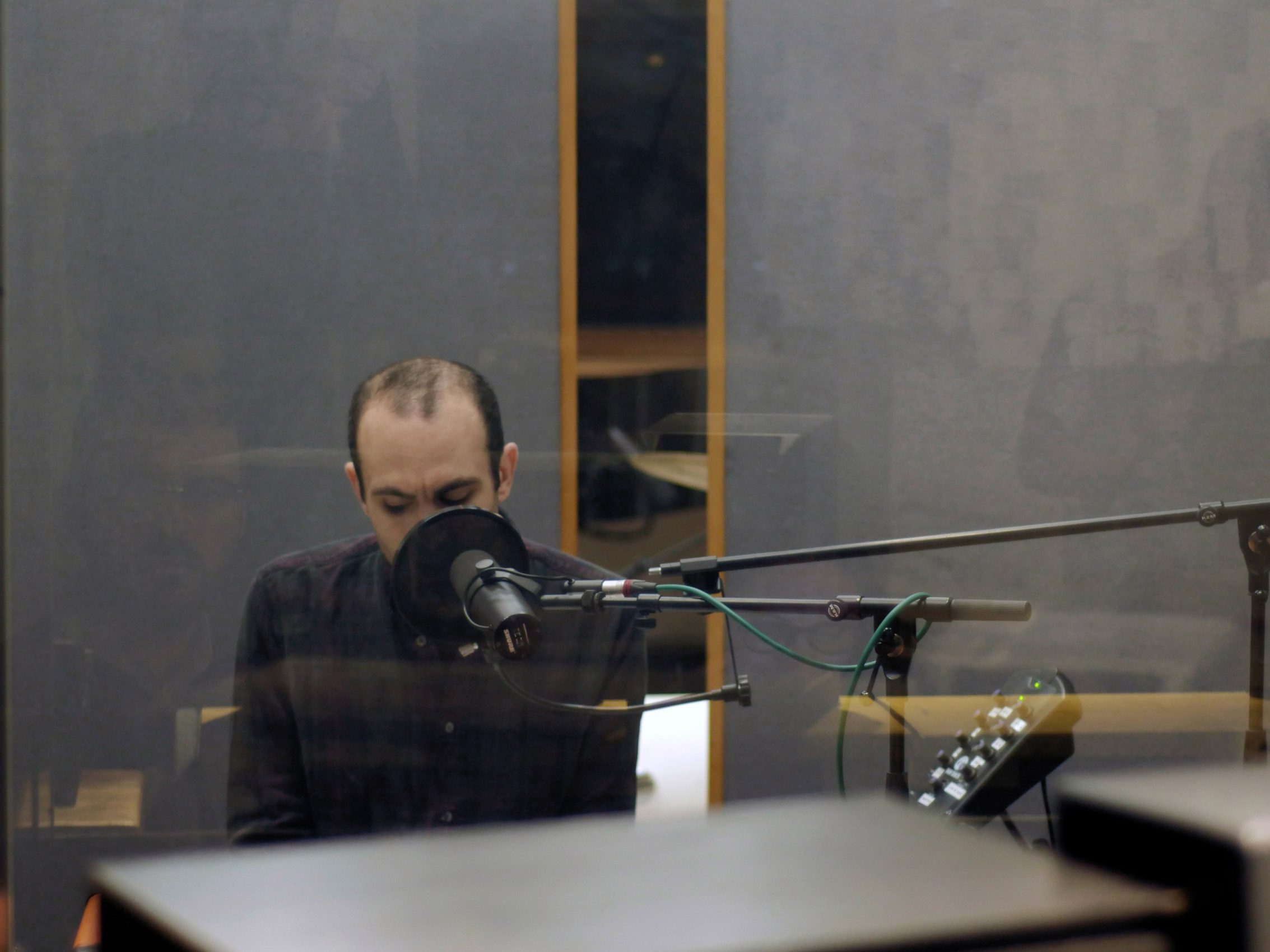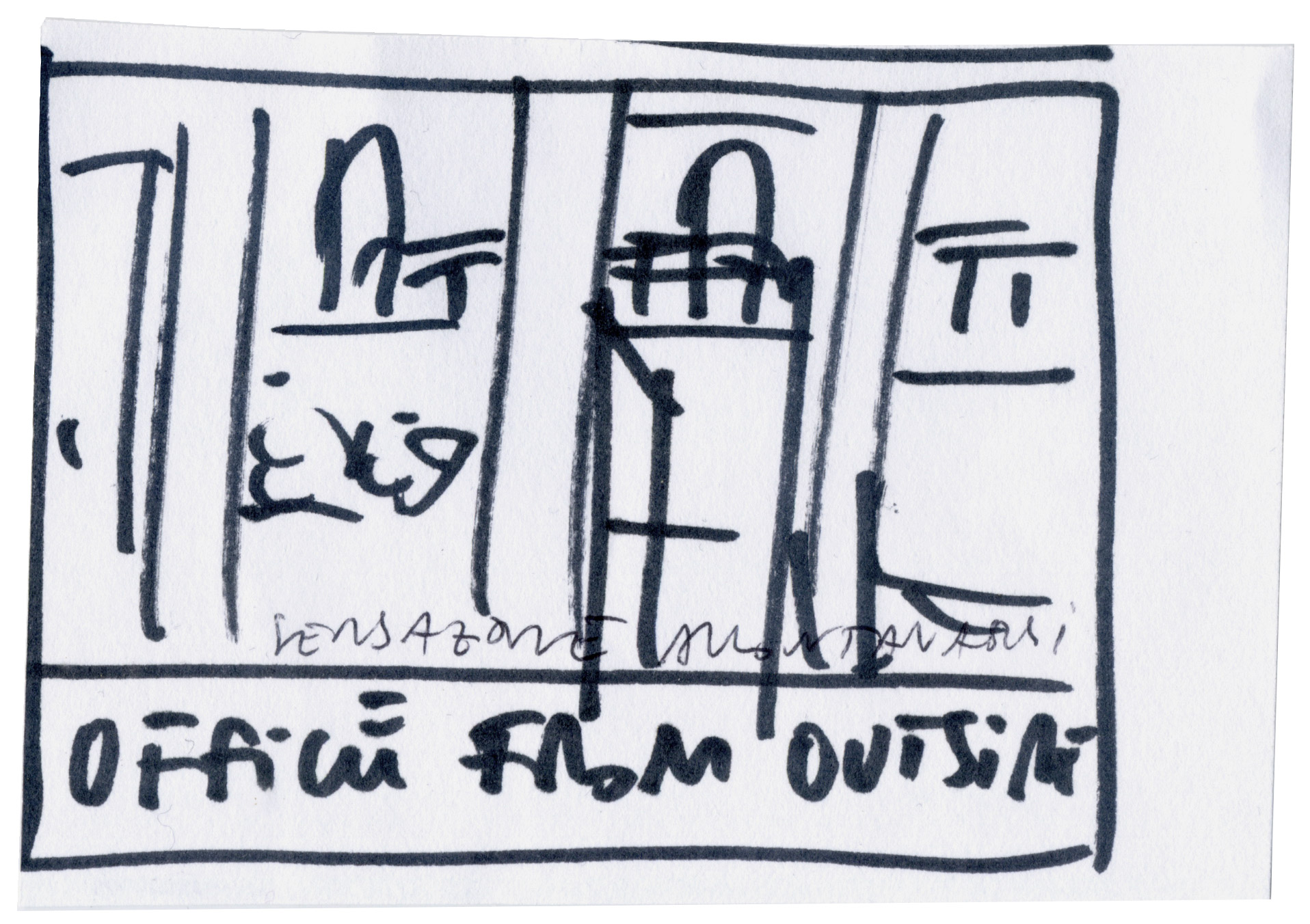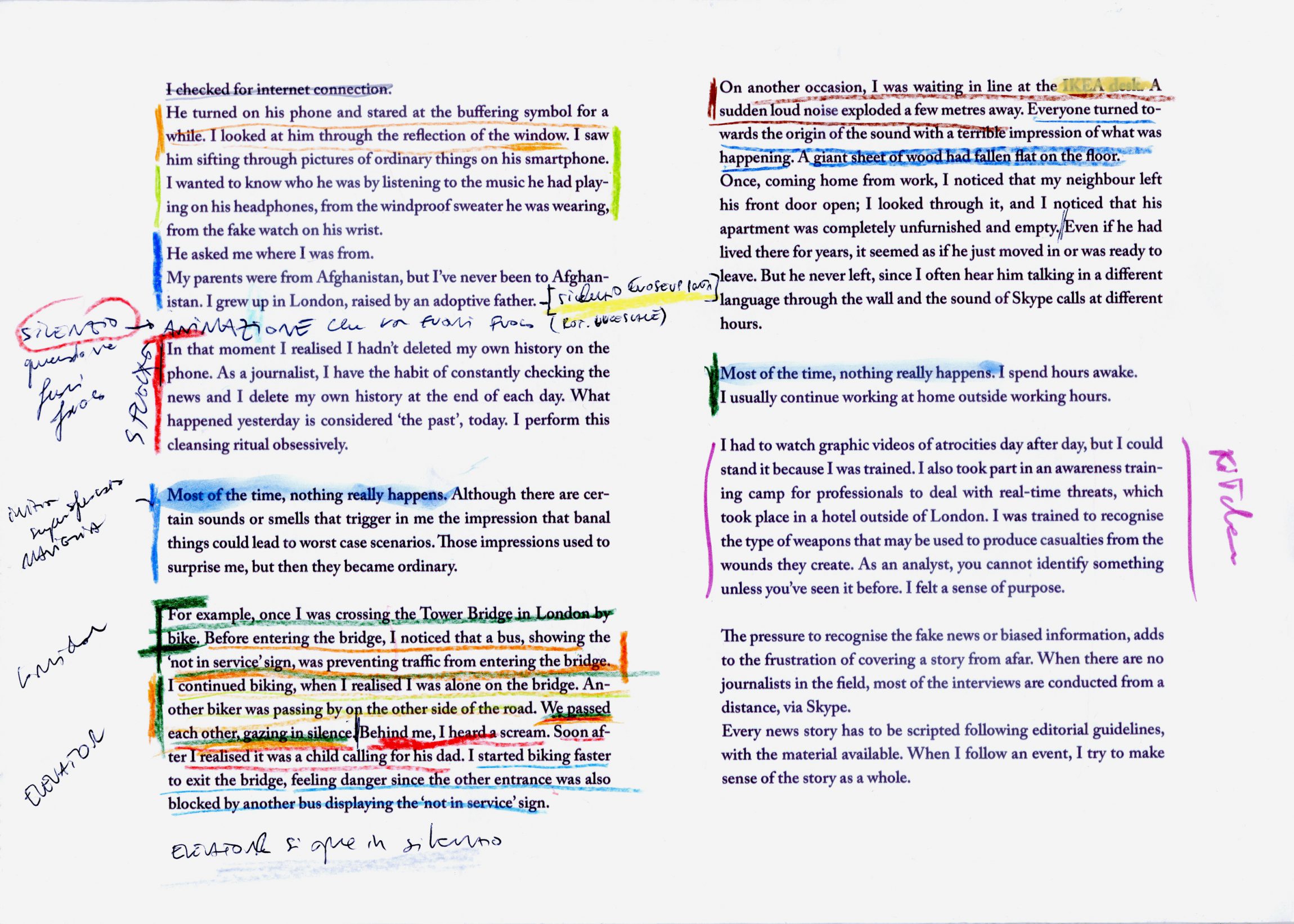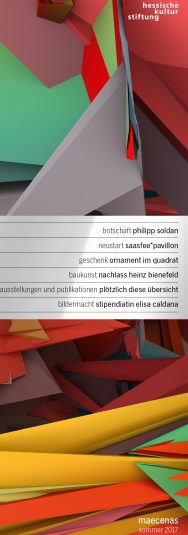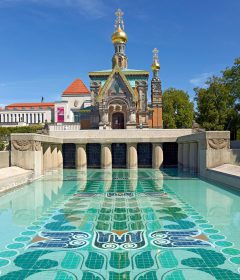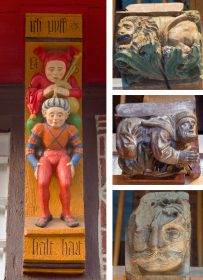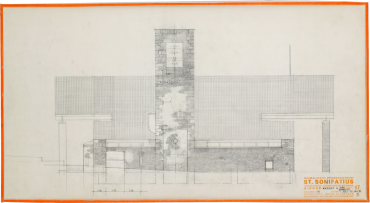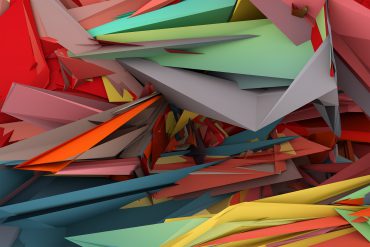stipendiatin elisa caldana
Elisa Caldana, 1986 in Pordenone geboren, hat im Anschluss an ein Studium in Visual Arts und Performance an der IUAV Universität Venedig (BA/MA) 2013 als Meisterschülerin bei Prof. Simon Starling an der Frankfurter Städelschule abgeschlossen. Während ihres Stipendiums im Londoner Atelier der Hessischen Kulturstiftung realisierte Caldana eine konzeptionelle filmische Arbeit in Kooperation mit dem Künstler Diego Tonus. Er studierte ebenfalls Visual Arts an der IUAV Universität Venedig und am Sandberg Instituut Amsterdam (MFA).
Zentrales Thema ihres gemeinsamen Projektes Topography of Terror (19. 12. 2016) sind die Effekte von Terrorismus in medialen Diskursen und verschiedenen gesellschaftlichen Gruppierungen. Ihre Fragen gelten dabei sowohl den direkten Opfern terroristischer Gewaltakte als auch deren indirekten Zielen. Im Rahmen dieser hochaktuellen investigativen Recherche hatten Caldana und Tonus unter anderem Kontakte zu Journalisten zum Beispiel der BBC, mit psychoanalytisch arbeitenden Experten und Instituten wie etwa dem Freud Museum, dem DART Center for Journalism and Trauma in London oder dem Bereich Forensic Architecture an der Goldsmiths University. Der titelgebende virtuelle Film-Raum basiert auf den Entwürfen des Schweizer Architekten Peter Zumthor für die Stiftung Topographie des Terrors in Berlin; der Gebäudekomplex wurde bekanntermaßen nicht realisiert.
Im folgenden dialogischen Text erläutern Elisa Caldana und Diego Tonus ihr Projekt. Die Uraufführung von Topography of Terror (19. 12. 2016) findet im Rahmen einer gemeinsamen Ausstellung der beiden Künstler im September 2017 in der Galerie ar/ge kunst des Kunstvereins Bozen statt. Die von Emanuele Guidi kuratierte Schau wird am 8. September 2017 um 19 Uhr eröffnet. Weitere Präsentationen der Arbeit in Deutschland und Großbritannien sind in Vorbereitung.
Elisa Caldana: Topography of Terror (19.12.2016) is the result of a two-year long collaboration with artist Diego Tonus, which culminated with the residency in London, offered by Hessische Kulturstiftung and managed by ACME Studios London in 2016. Our dialogue resulted in a film focusing on ways of constructing information in contemporary journalism, articulating a reflection on the role and the value of images as tools to perpetuate terror and manipulate our perception of reality.
Diego Tonus: During this year in London we had the possibility of meeting professionals in the field of journalism – among which BBC journalists – and collaborating with different Institutions, such as the Freud Museum. These conversations informed the script for our film. The work features a biographical story narrated from the point of view of a young journalist affected by secondary traumatic stress disorder.
EC: The journalist recounts the meeting and conversation that he had with a stranger, within a bus crossing the Channel Tunnel, on his way outside of the country (UK) – ‘the space of Brexit’. Within this very space of transit and while waiting for authority checks at the international border, the journalist reveals his concerns related to the job of being a producer of information and the effect that the overexposure to violent images has on his life and dreams.
DT: The conversation is centred on the character’s understanding of the effects of terrorism on everyday life, in relation to ordinary experiences, within public and private spaces. Through his thinking process, the work explores the impossibility of defining a unique topography of terror. His attention focuses on the schizophrenic nature of present-day terrorism, on its echoing through the non-places of the internet and the media (a virtual geography) and on its basing itself on the idea that it can happen anywhere at any time. Within this space of vulnerability (represented by the transit place of the Channel Tunnel, the border), each individual identity is called into question, including the other’s identity (the stranger’s identity).
EC: In the conversation with a stranger, the young journalist puts into doubt the very nature of his role in the system of news reporting and the ethical codes that guide the Newsroom. The character’s thinking process leads him to recognize the systemic nature of terrorism and the violence hidden within the definition of professional roles. Torn between the risk of being a perpetrator of terror – by spreading fear through sensationalism – and moral responsibility, the journalist asks himself: what is the future of the free man in a world where terror is the new normality?
DT: Thanks to the studio-visits we had during the year and the fortunate meeting with curator Gareth Evans, we had the great pleasure of getting in contact and work with actor Khalid Abdalla, who performed the script, lending his voice to the film. With Khalid, we went through the process of defining the psychology of the main character (the journalist) and its development within the script. The character’s psychological features have been performed by Khalid within his fascinating use of the voice, letting the doubts and suspicions of the journalist emerge in the film.
EC: The decision of inviting Khalid Abdalla to collaborate was motivated by how the actor’s biography resonates with the content of the film: among other roles as an actor, in United 93 – an acclaimed film that portrays the unfolding events of 9/11 – Khalid interpreted the role of Ziad Jarrah who served as the hijacker-pilot of United Airlines Flight 93. Furthermore, as an activist, he was one of the founding members of the Mosireen Collective in Cairo: a group of filmmakers and activists dedicated to supporting citizen media across Egypt in the wake of Mubarak’s fall.
DT: A key-aspect of the film is that it is set in a virtual space, in particular within the never-realised building for “Topographie des Terrors” Foundation in Berlin, originally conceived by Swiss architect Peter Zumthor as Documentation Centre, located on the site of buildings that during the Nazi regime – from 1933 to 1945 – were the headquarters of the Gestapo and the SS. In our film, the never-realized building plays the role of a virtual scenario and conceptual platform. Since it was never realised, it represents the image of a future-present that never came into being; it thus occupies an ideal place of potential futures and for this reason, it has become the platform for a discussion on current and potential future terrors.
EC: Initially, we worked on the project under the working-title of Topography of Terror. After the first editing of the film, we decided to include to the title the date: 19.12.2016. This decision was inspired by the way in which historical events are recorded and recalled both in media and historical narratives. 19.12.2016 is the date in which the conversation between the young journalist and the stranger takes place in our film. It is also a specific point in time which further connects the conversation to the contemporary discourse on terror. 19.12.2016 is the day in which the assassination of Andrei Karlov, the Russian Ambassador to Turkey, took place at an art exhibition in Ankara.
DT: The Computer Generated Images (CGI) of the building portrayed in this film and its interiors are a projection of our imagination. For the purpose of this project, we re-created the building as a detailed 3D model. This meticulous process developed over the course of six months. The process implied also the study of the materials and lights to use in order to recreate the building’s potential atmosphere. For this purpose, we travelled in Europe, visiting Peter Zumthor’s architectures to then decide the modalities of filming our model, considering it as a possible version of the original architecture itself.
EC: CGI can give access to ideas that are not yet realised, yet have the power to operate in the real by existing in potentiality. They inhabit an exceptional space that addresses expectations, desires and beliefs, in the attempt to persuade viewers of the alleged need for their future creation. This technique, often used in architectural visualisations, has been used in Topography of Terror (19.12.2016), not merely for its aesthetic fascination, but as the only tool to give shape to a mental image and finally explore it, challenging it through a cinematographic approach.
DT: The final editing of the film took place in the studio in London. By projecting the images of the building together with Khalid Abdalla’s voice over, we realised the importance of experiencing the work in a large-scale projection, so to be able to experience the void of the architecture and the contemplative atmosphere of the voice inhabiting the empty building.
The construction of this non-existing architecture during the residency in London and its potentiality as a conceptual platform, has opened to us the possibility of expanding the work in the future with further chapters of the film, written from the diverse points of view of the characters involved in the making-of the information of terrorism nowadays.
